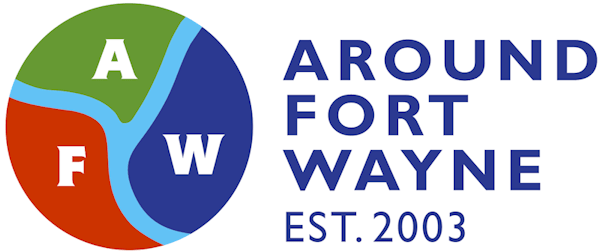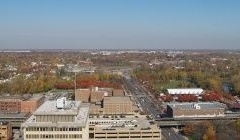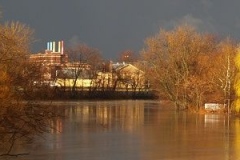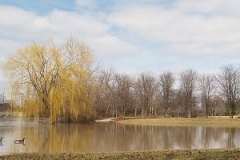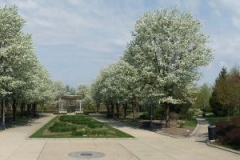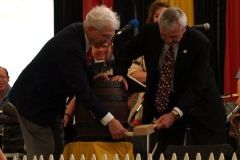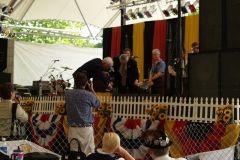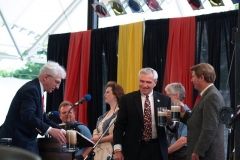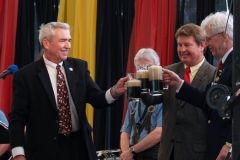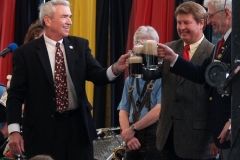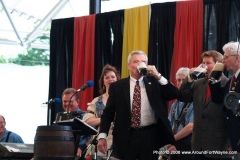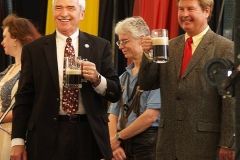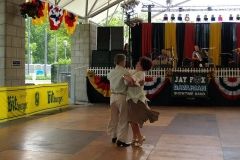
On August 5, 1986, Mayor Win Moses Jr. announced that the City of Fort Wayne intended to accept the Allen County offer to donate the Historic Wells Street Bridge to the city. In addition, the county was also giving the $20,000 it had earmarked to demolish the structure to the city for its’ restoration of the bridge. The Foellinger Foundation and Headwaters State Park Alliance each set aside $15,000 to help restore the bridge. (At this point in the Headwaters Park development, it was thought this area would have been part of the park, hence the donation.) The city was considering placing tables and lights on the bridge. The city was also accepting proposals for possible uses of the bridge once the restoration was completed. (Information gleaned from an article in the August 7, 1986 issue of the News-Sentinel from staff reports.)
In a News-Sentinel article on August 11, 1986, it was revealed that Bud Hall, owner of the local Hall’s Restaurant chain and Guesthouse Motel, had paid an engineer $600 to determine whether building a hotel on the bridge was feasible.
Picture a $500,000 downtown hotel featuring a dozen suites, glass walls and a patio with an angler’s-eye view of the St. Mary’s River.
Picture that structure built on the deck of the Wells Street Bridge.
The project wasn’t feasible, but Hall was quoted as saying:
I thought it’d be kind of wild and crazy . . . I think it would have been unique, I think I could have filled it and I think I could have turned a buck on it.
Patrons would have paid $55 per night to stay in one of the suites which would have consisted of a kitchen, living room and bathroom. Parking areas would have been on both ends of the bridge and the west side would have become a fenced-in patio area.
I just hated to see the bridge being torn down,” Hall recalled. “I didn’t want to adulterate the outside. I wanted to use the bridge as the superstructure and glass it in. When you looked at the bridge, it would look like it always did.Â
I figured on 80 to 90 percent occupancy. I went ahead and hired a bridge engineer to do a study on it,” Hall stated.
The report however revealed some troubling conclusions. It was impossible to predict the effects of strong winds whipping through the river channel on the glass hotel. In addition, the iron bridge was built with steel less pure and sturdy than materials available in 1986. Rust on some of the beams could have lessened their strength by 30 percent. These factors coupled together could have led to a collapse of the bridge deck beneath the hotel.
You don’t need to marry any more liabilities in your life,” Hall said. He acknowledged the plan was fanciful, but, “It cost me about $600 to have somebody tell me it wouldn’t hold up. I could have spent a half million dollars. It was worth the study.
If you think the idea of a hotel being built on top of a bridge strange, consider the London Bridge in 1209 when the decision was made to build structures including residences, shops and even a church on the sides of the bridge. A lane was left down the middle to accommodate traffic traversing the Thames River. The bridge was 26 feet wide, while the structures took up 7 feet on each side, leaving a 12 foot lane down the middle. Some of the structures extended over the side of the bridge by up to 7 feet.
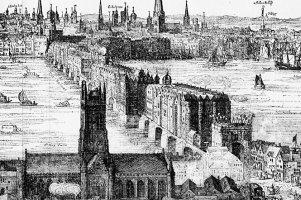
Wikipedia’s London Bridge article
which is the source for the London Bridge information included in this post
The Historic Wells Street Bridge was built in 1860 and used until 1981 when the Hugh McCulloch Memorial Bridge was built just South of the Fairfield Avenue and Ewing Street intersection.
